One of the most horrific subjects Jimison writes about is the women’s
ward.
“There was one thing at the
hospital that always harried my very soul.
It was the screaming of the women.
To me the most terrifying noise on earth is the anguished wail of a
demented woman. It has in it the pain of
perdition, the agony of a broken heart, the cold shuddering fear of a lost
soul.”
He recalls an elderly woman who would stand at her window and scream:
“What was going on in her tortured mind?
Was she hearing vulgar voices which shocked her sensitive nature with
ugly suggestions and indecent proposals?
Was she seeing ghosts and goblins and impish apparitions? Was she being haunted and tormented by the
recollection of unseemly conduct of the dim and distant past? Or was it Rachel weeping for her children
because they were not? Perhaps no one
would ever know. Apparently no one cared.”
The anonymous writer of The Women’s Ward at Morganton came from a prominent
family and studied at Queens College in Charlotte. In the summer of 1939, she entered Morganton
State Hospital due to a nervous condition.
At the beginning of each of her articles, the Charlotte News states her
identity is known to them, but because of the stigma of mental illness, they
have chosen to withhold her name.
Almost immediately, she discovered the horrific condition of the food. The admitting nurse informed her she arrived
too late for lunch and the hogs on the grounds ate the leftovers. The patient wrote, “I felt sorry for myself at
first, but when I saw the food, my sympathy was all for the hogs.” Jimison also spends a lot of time criticizing the
food, describing dishes filled with flies and once even a rat. He also describes a situation where a fellow
patient who suffered from itchy sores all over his head would be in charge of
handing out bread to the other patients while he scratched. Only when Jimison complained several times
and reached the top level of the administration was the patient relieved from his job of serving
bread to the tables.
The Woman’s Ward author was placed in the “front ward:” a dark, dismal area
where the walls had so much dirt on them they appeared black. Other patients told her she got the lucky
ward; the back wards contained women crowded into poorly ventilated rooms and
hallways where one bulb hung from the ceiling and the stench of human waste
made her gag. Forty women shared three
toilets that constantly overflowed; toilet paper was rationed but ran out within
three days. Although a tuberculosis
section existed, patients who suffered from TB and syphilis mingled together.
Every night the author shook out her bedding to get rid of the roaches
infested there. She longed to get
outside even for just a short time, but she soon learned the women were never
let outside for fresh air; many women were crowded onto a porch that only had
five chairs for 40 people, and some women had not set foot outside for decades. The nurses would herd some of the women from the
back wards onto the porches and lock the doors, leaving them there for hours. The porch had no bathroom facilities. The
author describes a nurse putting a fellow patient in a straight jacket and
locking her on the porch for hours on a cold November day.
While at Morganton, the anonymous female patient received only one medical examination. She describes doctors coming through the
hallways and barely even glancing at their patients. Jimison, however, speaks highly of some
doctors. He does deliver harsh criticism
of the attendants and nurses, almost all of whom were completely unqualified,
mostly illiterate, and severely underpaid.
Patients did a large amount of work cleaning for the hospital, working
long hours despite severe illness. The
anonymous author describes a woman who “…was about ready to go home. She was doing as much work as she was able to
do on the ward but the nurse ordered her to go to the hospital ward to
work. She begged not to go, saying that
she could not hold up the hospital work.
I think that she was going through the menopause. The nurse forced her to go and the inevitable
happened. She went berserk, was placed
on a back ward and was still there when I last heard of her.”
The hospital went to great lengths to uphold a reputable front while
covering up what actually happened within the wards. Nurses and attendants censored patient
correspondence and removed anything negative about the hospital. Some letters managed to get out, but many
were thrown away. Patients received
visitors in a spotless room in the front ward so not to give a negative
impression to family members. Any
complaints made by the patients were dismissed as “delusions”.

















